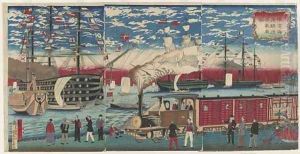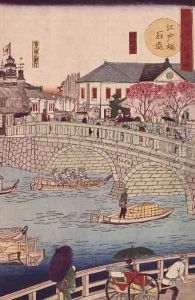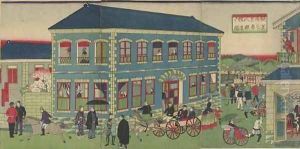Hiroshige III Paintings
Hiroshige III, originally named Gotō Torakichi, was a Japanese ukiyo-e artist known primarily for his landscapes and depictions of birds and flowers. Born in 1842, he was not a direct student of the famous Hiroshige (Ando Hiroshige), but rather a pupil of Hiroshige II. Upon the death of Hiroshige II, he married his master's widow and was allowed to adopt the Hiroshige name, thus becoming Hiroshige III. This practice of adopting a master's name and continuing their artistic lineage was common in Japanese traditional arts. Hiroshige III worked during the late Edo period and into the Meiji period, a time of significant transition in Japan from feudal society to modern state.
Hiroshige III's works are often characterized by the continuation of the styles and themes of his predecessors, especially the landscape series that had made Hiroshige's name synonymous with the genre of travel prints and scenic beauties. However, Hiroshige III also infused his works with the influences of the rapidly changing society around him. During the Meiji period, Japan underwent widespread modernization and opened up to Western influences. Hiroshige III captured these changes in his prints, depicting modern infrastructure like railways and telegraph lines alongside traditional Japanese landscapes.
Despite living in the shadow of the fame of the original Hiroshige, Hiroshige III managed to carve out his own niche in the art world. His contributions to the genre of ukiyo-e include not just landscapes but also works that reflect the societal changes of his time. His observations of the merging of traditional Japanese life with Western technology and customs offer a unique visual record of Japan's transition during the Meiji Restoration. Hiroshige III's work provides valuable insight into this pivotal period in Japanese history, making him an important figure in the study of ukiyo-e. He continued to produce art until his death in 1894, leaving behind a body of work that, while perhaps not as celebrated as that of Hiroshige I, is nonetheless esteemed for its historical and artistic value.


